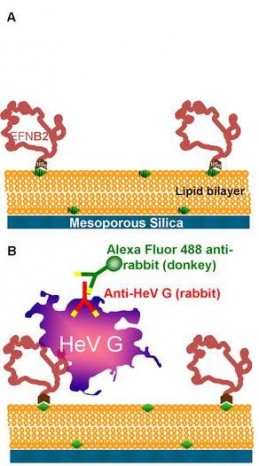Artificial, cell-Like ‘honey pots’ entrap deadly viruses
March 6, 2011
Researchers from the National Institute of Standards and Technology (NIST) and the Weill Cornell Medical College have designed artificial “protocells” that can lure, entrap and inactivate a class of deadly human viruses.
The technique offers a new research tool that can be used to study in detail the mechanism by which viruses attack cells, and might even become the basis for a new class of antiviral drugs.
“We often call them honey pot protocells,” says NIST materials scientist David LaVan, “The lure, the irresistibly sweet bait that you can use to capture something.”
Their work appears March 1 in PLoS ONE.
Henipaviruses, LaVan explains, belong to a broad class of human pathogens. Other examples include parainfluenza, respiratory syncytial virus, mumps and measles. A pair of proteins embedded in a two-layer lipid membrane act in concert to infect host cells. One, the so-called “G” protein, acts as a spotter, recognizing and binding to a specific “receptor” protein on the surface of the target cell.
The G protein then signals the “F” protein, explains LaVan, although the exact mechanism isn’t well understood. “The F protein cocks like a spring, and once it gets close enough, fires its harpoon, which penetrates the cell’s bilayer and allows the virus to pull itself into the cell. Then the membranes fuse and the payload can get delivered into the cell and take over.” It can only do it once, however.
The novel artificial cells achieved a near 100 percent success rate in deactivating experimental analogs of Nipah and Hendra viruses, two emerging henipaviruses that can cause fatal encephalitis (inflammation of the brain) in humans.
